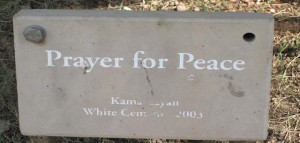“If every eight year old in the world is taught meditation, we will eliminate violence from the world within one generation.” –Dalai Lama
The Dalai Lama challenges us to crack the code for world peace by using meditation. Is meditation then, the key to non-violence in the world? It definitely seems like a great concept and action, and a single undertaking that will bring about greater peace within individuals. And when individuals feel more at peace within themselves, undoubtedly there is a flow-on effect, resulting in more peaceful interactions with all our connections. In this regard, meditation, may indeed be the single and foundational ingredient to world peace.
When I challenge myself to crack the code for world peace with just one word, I choose communication.
 It is through communication that all of our messages are transmitted, and all of our dealings with others. The ways in which I communicate beyond myself sets the level of peace or violence that emanates from me. If all of us choose to be at the disrespectful, angry or more violent end of the peace-violence continuum, that is what we are transmitting to the rest of the world – therefore adding our bit to the level of world violence. If, on the other hand, my communication is respectful and non-violent, then I am contributing my piece of peace to the world.
It is through communication that all of our messages are transmitted, and all of our dealings with others. The ways in which I communicate beyond myself sets the level of peace or violence that emanates from me. If all of us choose to be at the disrespectful, angry or more violent end of the peace-violence continuum, that is what we are transmitting to the rest of the world – therefore adding our bit to the level of world violence. If, on the other hand, my communication is respectful and non-violent, then I am contributing my piece of peace to the world.
 The single undertaking that I submit for world peace is respectful, non-violent communication at all levels.
The single undertaking that I submit for world peace is respectful, non-violent communication at all levels.
I am sure it is the case that as humans, we will always have a range of thoughts and feelings, and may be caught off guard on occasions. Our violent behaviour (be it in words or actions) mostly occurs when we are feeling anxious, fearful, stressed, threatened, hurt or in pain. We are more inclined in these situations to respond in a disrespectful manner, and any level of disrespect, in my opinion, is a level of violence.
There are times that disrespect of others occurs when communicating through humour – verbal or visual, such as in the form of cartoons. This may appear funny and harmless, however if people feel offended by our humour then the communication has been disrespectful.
The manner in which others receive our communication may not be aligned to the manner in which we perceive they should receive it, and this can cause us to judge them negatively and continue to believe that our communication is still harmless. If we continue to communicate in the same way that has already been identified as offensive, we are showing ongoing disrespect, perpetuating the violence.
Disrespectful words, actions and images to others (even if they are unintentionally so), may in turn, give rise to a disrespectful response from them, adding to, or even escalating, the level of violence. Changing our manner of communication is therefore crucial if we are to move forward more peacefully.
It is interesting to note that there are certain words in our language that were once considered quite acceptable to use, such as words to describe people from other cultures, and are now unlawful because of their disrespectful connotations; and more interesting to note that disrespect shown through other methods of communication, such as cartoons or comedy representations, are still considered lawful, with the onus being on the offended person or people to accept it.
We may justify humorous communication as harmless. Nevertheless, humour is a form of communication, and if we are to strive for the ideal of world peace, then any form of communication that is disrespectful, or violent, is an obstacle to this ideal.
I may not always be able to feel peaceful and be in control of my feelings, however I  minimise violence in my life, and do my bit for world peace, when I make a conscious decision about communicating to others in a respectful manner.
minimise violence in my life, and do my bit for world peace, when I make a conscious decision about communicating to others in a respectful manner.
Communication is my choice for cracking the code to world peace – love to hear what you come up with!
To keep up to date with Margaret’s articles and blogs, click HERE and enter your email address in the Subscribe section on the page, and click on the Go button. You will receive an email to confirm your subscription and you will need to click on the link in the email you receive in order to finalise your subscription.


Speak Your Mind